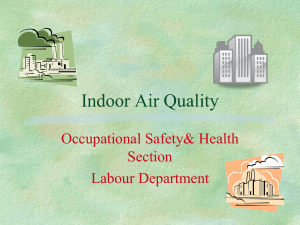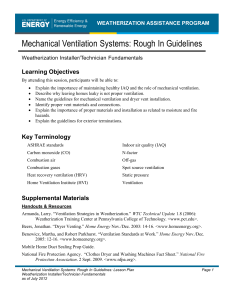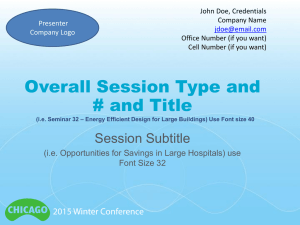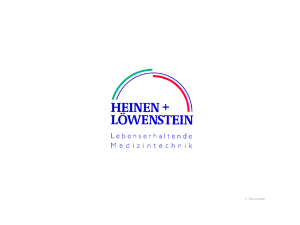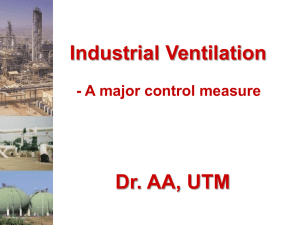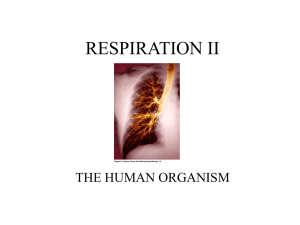ASHRAE 62 Summary
advertisement
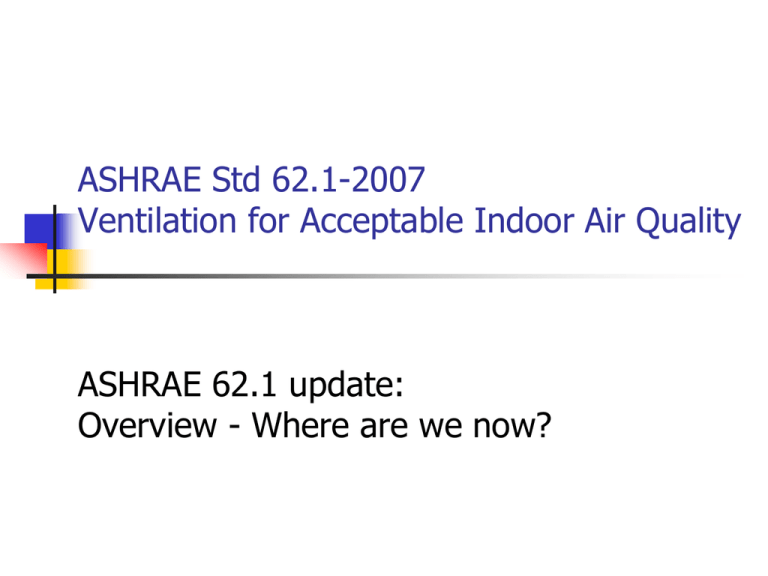
ASHRAE Std 62.1-2007 Ventilation for Acceptable Indoor Air Quality ASHRAE 62.1 update: Overview - Where are we now? ASHRAE Std 62 update An Outline General comments General requirements Ventilation requirements Construction and O/M requirements Questions ASHRAE Standard 62 What’s Its History? 62-1981 Alternative Air Quality Proc. 1970 62-1973 first issued 1980 62-1999 • IAQ-Health disclaimers • Smoking disclaimers • Clarified CO2as ventilation metric 62-2001 •Prescriptive •Commissioning •O&M •Combustion air •Filtration 62.1-2007 Updated 1990 62-1989 • Removed Thermal Comfort • Ventilation Rate Proc. • IAQ Proc. 2000 2010 62.1-2004 •Commercial and High Rise Res. •Enforceable code language •ETS vent. rates not covered •Vent. Rate. Proc. Modified •Occupant and area vent. rates ASHRAE Standard 62.1-2007 & Related Activities… Std 62.1-2007 is the most current version IMC adopted methodology and rates in 2007 Supplement Several educational courses are available from ASHRAE 62.1-2007 Purpose 1.1 Specify minimum ventilation rates and other measures intended to provide IAQ that is acceptable to human occupants and that minimizes adverse health effects. 1.2 Intended for regulatory application to new buildings, and additions 1.3 Guide the improvement of IAQ in existing buildings. 62.1-2007 Scope 2.1 All spaces intended for human occupancy. 2.2 Defines requirements for ventilation, aircleaning design, commissioning, installation and O&M 2.3 Additional requirements and other standards may apply (labs, healthcare, industrial, etc.) 2.4 May be applied to both new and existing buildings, not intended to be used retroactively 2.5 Does not prescribe specific ventilation rates for smoking spaces 62.1-2007 Scope Con’t 2.6 Ventilation requirements based on chemical, physical, & biological contaminants 2.7 Consideration or control of thermal comfort is not included 2.8 Contains requirements, in addition to ventilation related to certain sources 62.1-2007 Scope Con’t 2.9 Acceptable IAQ may not be reached in all buildings meeting these requirements because of special conditions noted Definition Acceptable Indoor Air Quality: air in which there are no known contaminants at harmful concentrations as determined by cognizant authorities and with which a substantial majority (80% or more) of the people exposed do not express dissatisfaction General Requirements 4.0 Outdoor Air Quality 4.1 Regional Air Quality Must determine NAAQS attainment status www.EPA.gov If nonattainment, air cleaning is required in some cases 4.2 Local Air Quality Conduct observational site survey to identify local sources of air contaminants General Requirements 4.0 Outdoor Air Quality 4.3 Documentation Regional air quality compliance status Local survey information Conclusions regarding acceptability of outdoor air quality General Requirements 5.0 Systems and Equipment 5.1 Natural Ventilation. Must meet minimum requirements for location and size of openings 5.2 Ventilation Air Distribution. Must provide means to adjust (balance) Must be sure that mixing occurs in RA/OA mixing plenums General Requirements 5.0 Systems and Equipment 5.3 Exhaust Duct Location. Operate exhaust ducts (with harmful contaminants) at negative pressure 5.4 Ventilation System Controls. Control to assure proper ventilation under any operating condition 5.5 Airstream Surfaces. Use materials that have documented resistance to microbial growth and erosion General Requirements 5.0 Systems and Equipment 5.6 Outdoor Air Intakes. Separate OA intake from outdoor contaminant sources Must comply with default minimum separation distances in Table 5-1. Examples: Loading dock Dumpster Surface below intake Cooling tower exhaust 25 ft 15 ft 1 ft 25 ft Must limit rain water penetration (using hood, proper velocity, etc.) or manage water that penetrates Must use bird screens and prevent bird nesting General Requirements 5.0 Systems and Equipment 5.7 Local Capture of Contaminants. Discharge air from non-combustion equipment with exhaust vents must be exhausted to outdoors 5.8 Combustion Air. Provide combustion air and exhaust air for indoor fuel-fired appliances Products of combustion from vented appliances shall be vented directly outdoors. General Requirements 5.0 Systems and Equipment 5.9 Particulate Matter Removal. Use a filter with a MERV 6 (or greater) upstream of dehumidifying coils and other wet-surface devices in supply stream General Requirements 5.0 Systems and Equipment 5.10 Dehumidification Systems. Must limit indoor RH to 65% or less at design dew point condition Exception to RH limit: where occupancy requirements or processes dictate higher RH conditions. Intake airflow must be greater than relief/exhaust during cooling (to minimize moist air infiltration) General Requirements 5.10 Dehumidification Systems 65% RH limit 62°F DP General Requirements 5.0 Systems and Equipment 5.11 Drain Pans. Assure drainage without flooding or carryover Slope: 1/8” per foot toward outlet Drain: At lowest point, large enough to prevent overflow Drain seal: P-trap or other seal for negatively pressurized drain pans to prevent ingestion of air while allowing complete drainage (fan on or off) Pan size: length at least 1/2 coil height or as necessary to limit carryover General Requirements 5.0 Systems and Equipment 5.12 Finned Tube Coils and Heat Exchangers Use drain pan Select to limit coil pressure drop to 0.75 in.wc.@ 500 fpm face velocity If higher pressure drop, provide access on both sides for maintenance General Requirements 5.0 Systems and Equipment 5.13 Humidifiers and Water Spray Systems Use potable water (or better) No downstream devices within absorption distance 5.14 Access for Inspection, Cleaning and Maintenance. General Requirements 5.0 Systems and Equipment 5.15 Building Envelope and Interior Surfaces Weather barrier to prevent water penetration into envelope Vapor retarder or other means to prevent condensation on cold surfaces within envelope Seal all seams, joints, penetrations to limit infiltration Insulate pipes, ducts expected to have surface temperature below surrounding dew point General Requirements 5.0 Systems and Equipment 5.16 Buildings with Attached Parking Garages. Limit infiltration of vehicular exhaust Maintain garage pressure at or below adjacent occupied space Or, use a vestibule Or, otherwise design to minimize air migration from garage to occupied space General Requirements 5.0 Systems and Equipment 5.17 Air Classification and Recirculation. Limit recirculation or transfer of “dirty” air to “cleaner” spaces 5.17.1 Classification - Designate air leaving each space using Table 6.1 Class 1: Low contaminant concentration (office) Class 2: Moderate concentration (dining room) Class 3: Significant concentration (sick room) Class 4: Highly objectionable or potentially harmful concentration General Requirements 5.0 Systems and Equipment 5.17.1 Classification Manage recirculation as follows Class Class Class Class Class 1 2 4 3 4 to anywhere to self, similar Class 2 or Class 3 or to self to outdoors General Requirements 5.0 Systems and Equipment 5.17.2 Re-designation of air class Air Cleaning. May reclassify air cleaned by passing it through an appropriate aircleaning system Transfer. Mixed classes are re-designated. Energy Recovery. Energy recovery from class 2 (exhaust) airstreams must have no more than 10% leakage into a class 1 airstream. General Requirements 5.0 Systems and Equipment 5.18 Requirements when building has both ETS and ETS-Free areas. Does not purport to achieve acceptable IAQ in ETS areas. Spaces must be classified as ETS or ETS-Free Air must be kept separate by means of walls, automatic door closers and pressurization General Requirements 5.0 Systems and Equipment 5.18 (continued) Recirculation or transfer from ETS to ETS-Free is prohibited ETS areas must be exhausted to the outdoors Ventilation Requirements 6.0 Procedures 6.1 General. Ventilation Rate Procedure or IAQ Procedure for outdoor airflow values for mechanical ventilation systems 6.1.1 Ventilation Rate Procedure. Prescribes rates & procedures based on typical space contaminant sources & source strengths Ventilation Requirements 6.0 Procedures 6.1.2 IAQ Procedure. Requires calculation of rates based on analysis of contaminant sources, concentration targets and perceived air quality targets. Construction Requirements 7.0 Construction/Start-Up 7.1 Construction Phase Don’t operate air handlers without filters Protect building materials Protect occupied areas Limit migration of construction contamination into occupied space Construction Requirements 7.0 Construction/Start-Up 7.1.5 Air Duct Construction shall be in accordance with the SMACNA duct construction standards and NFPA standards governing installation of HVAC systems 7.2 System Start-Up. Balance airflow values, test drain pans, clean up before starting, test damper controls Construction Requirements 7.0 Construction/Start-Up 7.2.6 Documents including balance report, construction drawings and design criteria with assumptions shall be provided to Owner Operating Requirements 8.0 Operation & Maintenance 8.2 Operations and Maintenance Manual. Develop and maintain a building operations and maintenance manual which shall include a maintenance schedule with frequencies of tasks. Operating Requirements 8.0 Operation & Maintenance 8.3 Ventilation System Operation. Operate in accordance with Building Operations Manual 8.4 Ventilation System Maintenance. Maintain in accordance with Building Operations Manual. Operating Requirements 8.0 Operation & Maintenance 8.4.1.4 Coil drains. Drain pans shall be inspected at least once a year and cleaned if required 8.4.1.8 Outside Air Flow Verification. For units >2,000 cfm the outside air flow shall be tested a minimum of every 5 years and adjustments shall be made to have the design flow provided to system ASHRAE 62.1 Standard is under continuous maintenance process You can propose a change to the standard Notice of proposed changes appears in ASHRAE Standards Action You can comment on proposed changes You can request an interpretation ASHRAE 62.1 User’s manual for 62.1-2007 IMC & UMC Code adoption ALI Short Course and Professional Development Course eLearning course IAQ Design Guideline is in the works Next publication of ASHRAE 62.1, 2010 Questions? ASHRAE 62.1 update: Overview - Where are we now?
